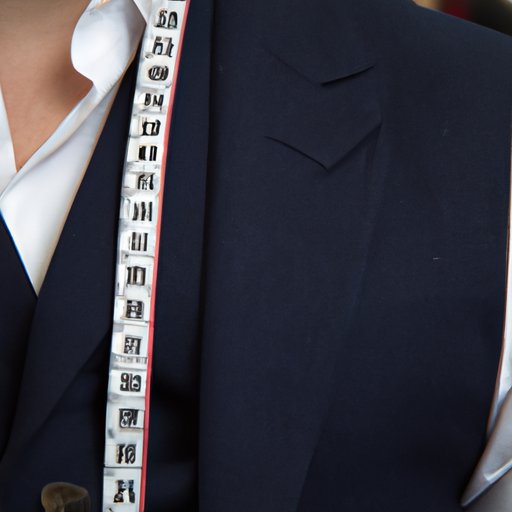
Introduction
Choosing the right suit can make all the difference in your appearance and confidence. However, the process of measuring for a suit can be overwhelming and confusing, especially if you’re doing it for the first time. Taking accurate measurements is crucial to getting the right fit. This article will provide you with a comprehensive guide to measuring for a suit that fits you properly and comfortably.
The basics of measuring for a suit
Before delving into the measurement process, it is essential to understand the purpose of a suit. A suit is a two or three-piece outfit made of matching fabric typically worn for formal occasions. Choosing a suit that fits correctly can not only elevate your style but also enhance your confidence and make you feel good about yourself.
There are different types of suits available in the market, including two-piece and three-piece suits. A two-piece suit consists of a jacket and trousers, while a three-piece suit includes a vest in addition to the jacket and trousers. When measuring for a suit, ensure that you’re wearing the type of clothes that you will wear with the suit. This will give you a more accurate measurement.
Tools needed for measuring
There are specific tools that you will need to take accurate measurements for your suit. These include a measuring tape, pencil, notepad, and a friend to assist you. A measuring tape is essential for taking measurements, while a pencil and notepad will come in handy to record your measurements. Having a friend assist you will make the process easier and quicker as they can hold the tape and help with the process.
The measurement process
The measurement process involves taking measurements of different parts of your body to ensure that the suit fits you perfectly. It is essential to take measurements carefully, as fitting a suit cannot be done accurately through guesswork. Break down the measurement process into different sections of the body:
Measuring the chest
The chest measurement is crucial in determining the correct size for your jacket. Place the measuring tape around the broadest part of your chest, which is just under your armpits. The tape should be snug but not too tight as to restrict movement or breathing.
Measuring the waist
The waist measurement is essential in determining the right fit for your trousers. Place the measuring tape around the narrowest part of your waist, which is about an inch or two above your belly button. The tape should be snug but not too tight as to restrict movement or breathing.
Measuring the hips
To take the hip measurement, place the measuring tape around the widest part of your hips and buttocks. This measurement is essential in determining the right fit for your trousers. Take note of this measurement as it is generally the largest of all your measurements.
Measuring the inseam
The inseam measurement is crucial in determining the right length for your trousers. Place the measuring tape at the highest point of your inner thigh and take the measurement down to your ankle bone. This measurement should be just above your shoe for a slim and modern look.
Measuring the sleeve length
For the sleeve length measurement, place the measuring tape at the center of your back, and let it run down towards your wrist. The tape should stop just at the wristbone to ensure that the sleeve length of the jacket is perfect.
Using diagrams and infographics
Diagrams and infographics aid in visualizing the measurement process, making it easier for you to understand the technique used. You can find these infographics online or use the ones we’ve provided to give you a clearer picture of what to do.
Ensuring accuracy
To ensure that your measurements are accurate, stand straight with your arms down by your side. Avoid pulling the measuring tape too tight or too loosely, but instead, keep the tape snug. Always take your measurements multiple times to ensure that they are accurate.
Common mistakes when measuring for a suit
Common mistakes when measuring for a suit include taking inaccurate measurements, measuring with clothing on, or measuring alone. These mistakes can lead to an uncomfortable fit, which can affect your style and confidence. To avoid these mistakes, ensure that you follow the measuring process carefully and take your measurements with a friend.
Tips for the right fit
Proper fitting is crucial to achieving the perfect look and feel for your suit. To ensure that you get the right fit, try on different sizes and styles to find one that feels comfortable on you. A well-fitting suit should be snug but not too tight, with enough room to breathe and move around.
Minor adjustments can be made to your suit to make it fit just right. For example, the length of the sleeves, trouser length, and waistband can be adjusted to achieve a better fit. Some tailors may include these adjustments as part of their services, or you may choose to do them yourself.
Additional resources
Measuring for a suit can be overwhelming at first, but it gets easier once you have done it a few times. You can use additional resources like video tutorials or measuring apps to help you with the process. There are also online support communities where you can ask questions and receive support from people who have gone through the process before.
Conclusion
Measure your suit carefully to ensure that it fits you well and looks amazing. Use this comprehensive guide as a reference point to assist you with your measurements, and remember to take your measurements carefully. Don’t be afraid to try on different sizes and styles and make minor adjustments until your suit fits and feels just right. After all, a well-fitting suit will transform your look and build your confidence.




